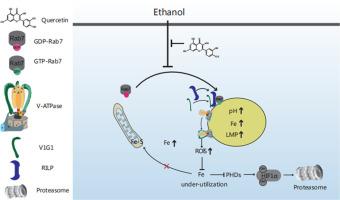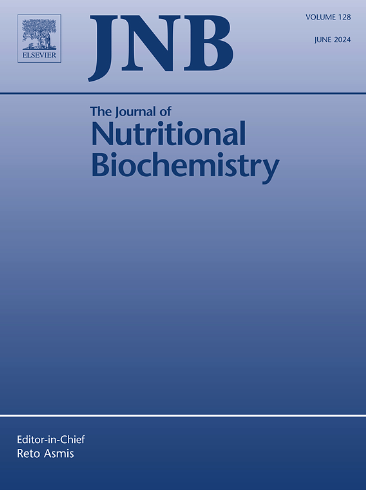Refining the Rab7-V1G1 axis to mitigate iron deposition: Protective effects of quercetin in alcoholic liver disease
IF 4.8
2区 医学
Q1 BIOCHEMISTRY & MOLECULAR BIOLOGY
引用次数: 0
Abstract
Iron overload is a common feature of alcoholic liver disease (ALD) and contributes significantly to disease progression. Quercetin, a flavonoid known for its iron-chelating properties, has emerged as a potential protective compound against ALD. However, research on quercetin's regulatory effects on iron levels in ALD is limited. To address this, we conducted a study using male C57BL/6J mice were subjected to a Lieber De Carli liquid diet containing ethanol (28% energy replacement) with or without quercetin supplementation (100 mg/kg.BW) for 12 weeks. Additionally, HepG2 cells, after transfection with the CYP2E1 plasmid, were incubated with ethanol and/or quercetin. Our findings revealed that ethanol consumption led to iron overload in both hepatocytes and lysosomes. Interestingly, despite the increase in iron levels, cells exhibited impaired iron utilization, disrupting normal iron metabolism. Further analysis identified a potential mechanism involving the Rab7-V1G1 (V-ATPase subunit) axis. Inhibition of V-ATPase by Concanamycin A caused elevated ROS levels, impaired lysosomal and mitochondria function, and increased expression of HIF1α and IRP2. Ultimately, this disruption in cellular processes led to iron overload and mitochondrial iron deficiency. Quercetin supplementation mitigated ethanol-induced hepatocyte damage by reversing iron overload through modulation of the Rab7-V1G1 axis and improving the interaction between lysosomes and mitochondria. In conclusion, this study elucidates a novel pathophysiological mechanism by which quercetin protects against ALD through its regulation of iron homeostasis.

完善 Rab7-V1G1 轴以减轻铁沉积:槲皮素对酒精性肝病的保护作用。
铁超载是酒精性肝病(ALD)的一个常见特征,对疾病的进展起着重要作用。槲皮素是一种黄酮类化合物,以其螯合铁的特性而闻名,它已成为一种潜在的防止酒精性肝病的保护性化合物。然而,有关槲皮素对 ALD 中铁水平的调节作用的研究还很有限。为了解决这个问题,我们用雄性 C57BL/6J 小鼠进行了一项研究,让它们食用含有乙醇(28% 的能量替代)的 Lieber De Carli 液体饮食,同时补充或不补充槲皮素(100 mg/kg.BW),持续 12 周。此外,用 CYP2E1 质粒转染 HepG2 细胞后,与乙醇和/或槲皮素一起培养。我们的研究结果表明,服用乙醇会导致肝细胞和溶酶体中铁超载。有趣的是,尽管铁含量增加了,但细胞对铁的利用却出现了障碍,破坏了正常的铁代谢。进一步分析发现了涉及 Rab7-V1G1(V-ATP 酶亚基)轴的潜在机制。康那霉素 A 抑制 V-ATP 酶会导致 ROS 水平升高、溶酶体和线粒体功能受损以及 HIF1α 和 IRP2 表达增加。细胞过程的这种破坏最终导致铁超载和线粒体缺铁。补充槲皮素可通过调节 Rab7-V1G1 轴和改善溶酶体与线粒体之间的相互作用来逆转铁超载,从而减轻乙醇诱导的肝细胞损伤。总之,本研究阐明了槲皮素通过调节铁稳态防止 ALD 的一种新的病理生理机制。
本文章由计算机程序翻译,如有差异,请以英文原文为准。
求助全文
约1分钟内获得全文
求助全文
来源期刊

Journal of Nutritional Biochemistry
医学-生化与分子生物学
CiteScore
9.50
自引率
3.60%
发文量
237
审稿时长
68 days
期刊介绍:
Devoted to advancements in nutritional sciences, The Journal of Nutritional Biochemistry presents experimental nutrition research as it relates to: biochemistry, molecular biology, toxicology, or physiology.
Rigorous reviews by an international editorial board of distinguished scientists ensure publication of the most current and key research being conducted in nutrition at the cellular, animal and human level. In addition to its monthly features of critical reviews and research articles, The Journal of Nutritional Biochemistry also periodically publishes emerging issues, experimental methods, and other types of articles.
 求助内容:
求助内容: 应助结果提醒方式:
应助结果提醒方式:


